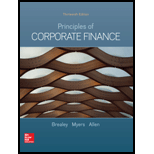
Concept explainers
a)
To identify: The marginal investors that determine the prices of the stocks.
a)
Explanation of Solution
The marginal investors who determine the prices of the stocks are institutions.
b)
To determine: The prices of the low-, medium-, and high-payout stocks.
b)
Explanation of Solution
Computation of price of the low-, medium-, and high-payout stocks is as follows:
Therefore, the price of low-, medium-, and high-payout stock is $166.67, $83.333, and $250 respectively.
c)
To determine: The after-tax returns of the three types of stock for each investor group.
c)
Explanation of Solution
The institution after-tax
Therefore, the individuals after-tax rate of return of low-, medium-, and high-payout stock is 9.15%, 8.10%, and 6% respectively.
For corporations, after-tax rate of return is as follows:
Therefore, the corporations after-tax rate of return of low-, medium-, and high-payout stock is 8.70%, 9.60%, and 11.40% respectively.
d)
To determine: The dollar amounts of the three types of stock held by each investor group.
d)
Explanation of Solution
Following table shows the dollar amounts of the three types of stock held by each investor group:
| Low payout | Medium payout | High payout | |
| Individuals | $80 billion | ||
| Corporations | $10 billion | ||
| Institutions | $20 billion | $50 billion | $110 billion |
Table no.1
Want to see more full solutions like this?
Chapter 16 Solutions
Principles of Corporate Finance
- Take value of 1.01^-36=0.699 . step by steparrow_forwardsolve this question.Pat and Chris have identical interest-bearing bank accounts that pay them $15 interest per year. Pat leaves the $15 in the account each year, while Chris takes the $15 home to a jar and never spends any of it. After five years, who has more money?arrow_forwardWhat is corporate finance? explain all thingsarrow_forward
